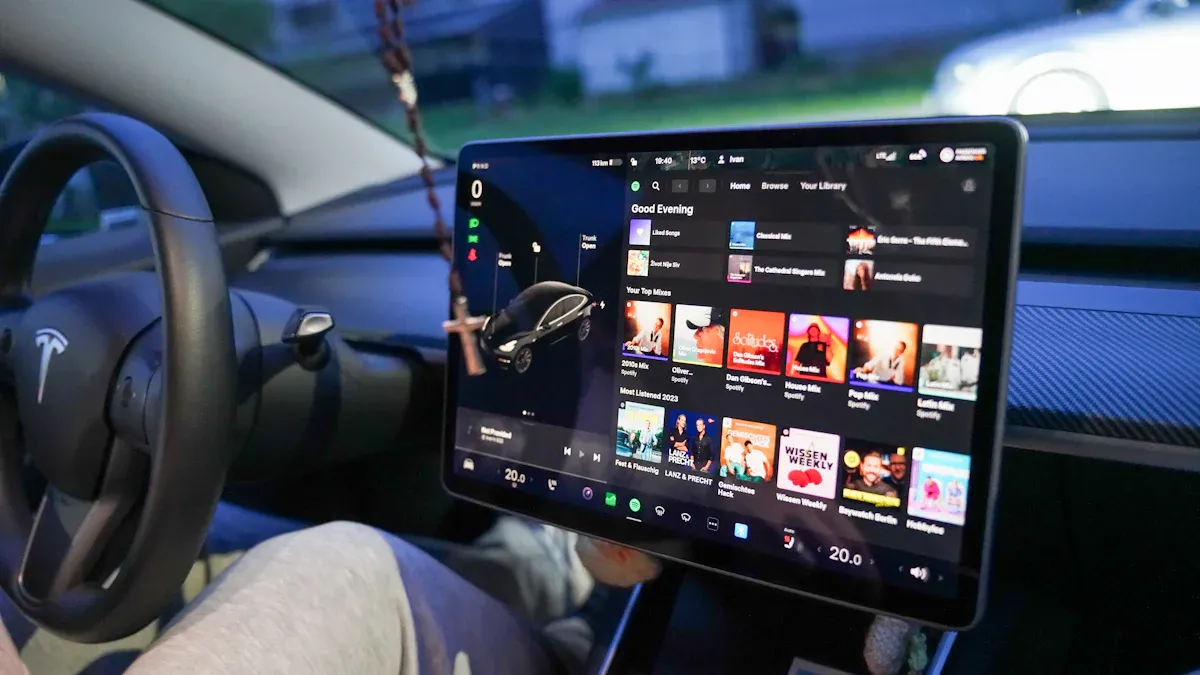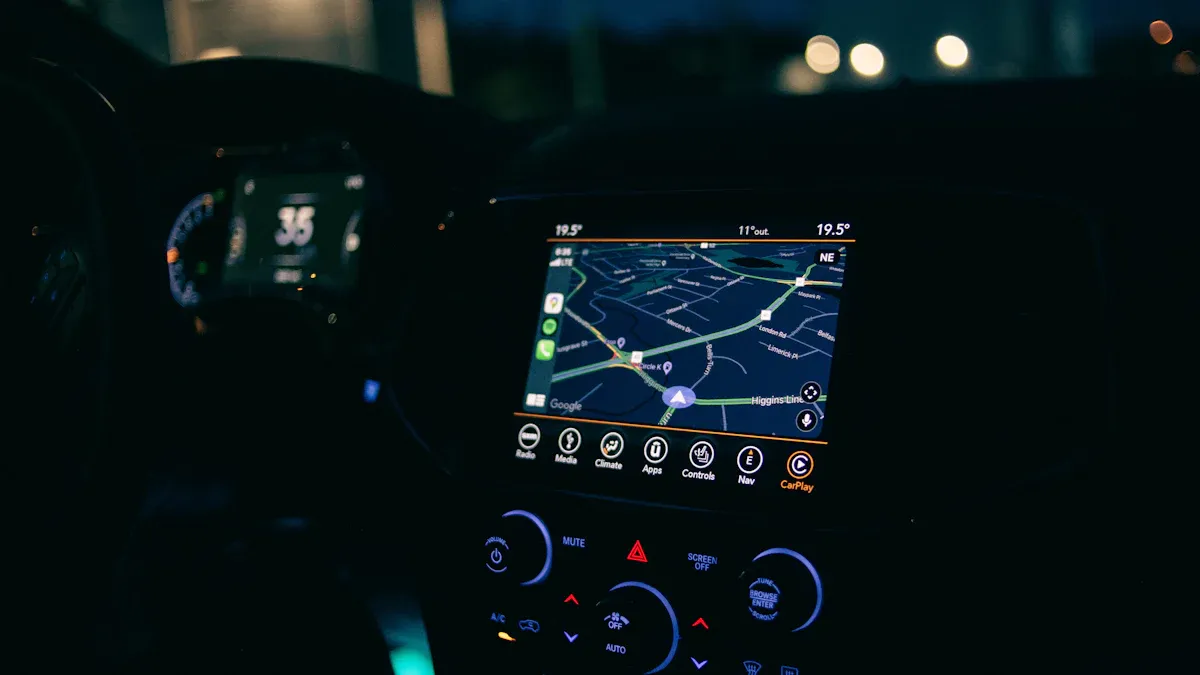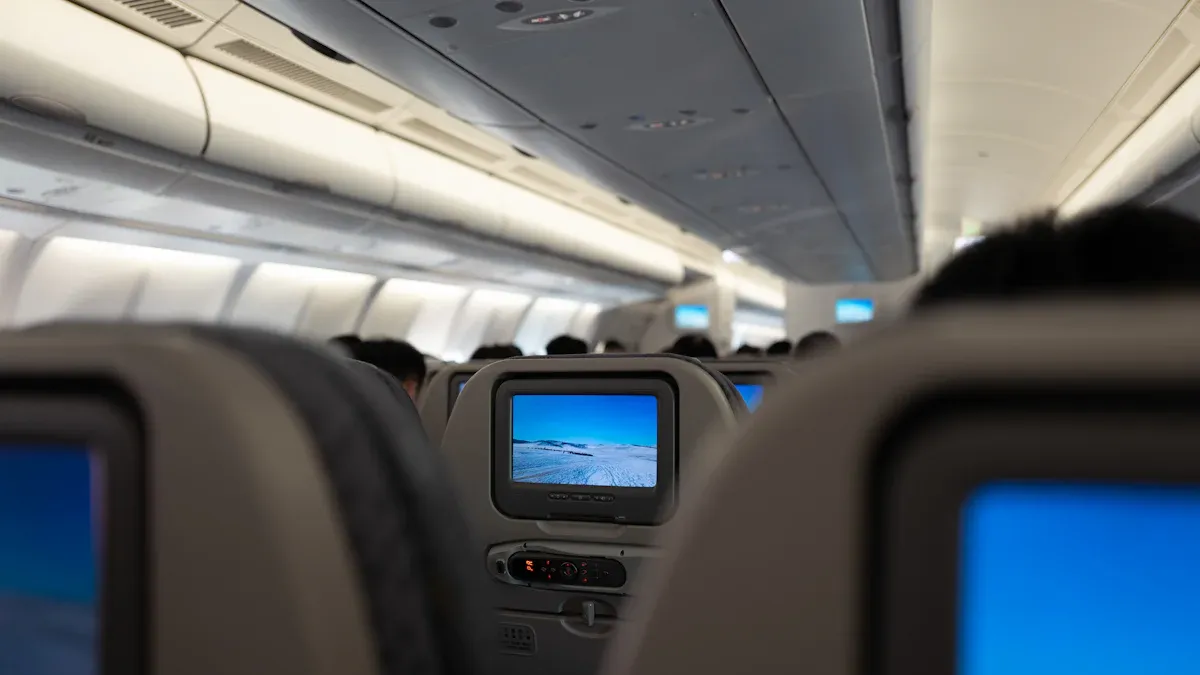
Interactive headrest ad screens are a new trend in car ads. They use digital tools, new technology, and make ads feel personal. The market for these screens is growing fast. Experts think global sales will go from $37.46 billion in 2024 to almost $64 billion in 2034. North America has more than 35% of this market. New things like Android systems, AR, and HD screens help change digital ads. These features make passengers pay more attention. They also change how ads work inside cars. Car makers and advertisers use these screens for special and fun ad campaigns.
Key Takeaways
Interactive headrest ad screens use AI, AR, and HD displays. These tools make car ads more personal for passengers. They also make ads more fun and interesting. These screens show ads based on passenger data and location. This helps advertisers reach the right people in a better way. Touchscreens and games are interactive features. They keep passengers interested. They also help people remember the ads. The market for these screens is growing very fast. New technology and more city demand help this growth. There are some problems like privacy, costs, and ad fatigue. But smart technology and good content help companies solve these problems.
Technology Trends

AI Content
AI is changing how car ads work. Interactive headrest ad screens use AI to show content made just for each passenger. These screens look at passenger data and change ads right away. AI helps advertisers send the best message to each person. This makes people pay more attention to taxi ads. It also makes ads work better. AI tracks how people use the screens to help improve ad campaigns. Because of this, car companies get more value from their ads. AI content is a big part of new digital changes in cars.
AR Experiences
Augmented reality brings new ideas to interactive headrest ad screens. Now, passengers can use digital overlays on the screens. For example, they can try on products or play games during their ride. This makes taxi ads more fun and interesting. AR uses machine learning to show ads that match what each person likes. Real-time analytics help advertisers see which AR ads work best. Car brands use these tools to make ads that people remember in a busy market.
Tip: AR experiences in taxi ads help passengers pay more attention and remember the digital content.
HD Displays
High-definition displays are now common in car ads. Taxi headrest screens have HD resolution, waterproof cases, and sometimes two screens. These displays show clear pictures and videos, so ads look better. HD screens work well in any light, so passengers see everything. Taxi ad companies like these screens because they last longer and need less fixing. Two screens let advertisers show different ads to each passenger, so more people see the ads. HD displays can show many types of content, like banners or games.
Android Systems
Many new interactive headrest ad screens use Android-based systems. These systems are flexible and work well with other car tech. Android platforms support many ad types, like videos, apps, and live updates. Taxi ad companies use Android to control content from far away and change ads fast. This helps advertisers keep up with what people want. Android systems also have cool features like voice control and gesture recognition, so screens are easier to use. Car brands like Android because it is easy to grow and very reliable.
Note: Android systems make it easy to update and add new ad ideas to car digital displays.
3D and holographic ad formats are the next big thing in taxi ads. Some companies use 3D hologram fan displays to show cool images and videos. These displays make amazing effects that get people’s attention. Right now, taxi headrest LCD screens do not have full 3D or holographic content. But this technology could be used in the future. Car advertisers keep looking at these ideas to make ads more exciting and start new trends in digital ads.
Personalization & Data
Targeted Ads
Car ads now use smart digital tools to find the right people. Headrest ad screens have touch LCDs that let passengers interact. Companies pick ads for each person’s age or group. GPS helps show ads that fit where the car is. Advertisers can change ads fast from far away. T-Mobile Advertising Solutions uses GPS and other data for special ads in many ride-hailing cars. Passengers can play games with brands or answer questions. This makes people join in and pay more attention. These ways help car brands reach more people in new ways.
Touchscreen LCDs keep passengers watching the screen.
Location-based tools show ads that fit where you are.
Remote CMS lets ads be changed without being there.
Tip: Targeted ads in cars work better and keep content new for everyone.
Data Analytics
Data analytics helps car ads do better. Advertisers look at what people say about the ads. They use real-time data to see which ads people like most. This helps them change ads to get better results. Car ads can match bigger ad campaigns outside the car. Data analytics also shows what people like and do. This makes it easier to show the right ads to the right people. Car companies use these facts to stay ahead in a fast market.
Data Analytics Benefits | Automotive Market Impact |
|---|---|
Real-time feedback | Faster campaign updates |
Consumer insights | Improved ad targeting |
Trend analysis | Better market response |
Adaptive Content
Adaptive content makes car ads more interesting. AI and machine learning help make ads just for each person. Real-time analytics let the system change ads for what people like. High-res screens like 4K and OLED make ads look great. Screens can connect with phones and online sites for a smooth experience. Car makers and ad tech companies work together for easy-to-use solutions. These smart ways keep ads fresh and make people pay more attention.
AI content management makes ads fit each person.
Dynamic changes help meet what people want.
Omnichannel marketing links digital and car ads.
Note: Adaptive content helps car ads stay new and easy to manage.
Passenger Engagement

Interactive Features
Interactive features on headrest screens have changed ads in cars. Passengers can use touchscreens, QR codes, and NFC technology. These tools let people talk back to the ads. Passengers can play games or answer surveys. They can also scan codes to get special deals. This makes people spend more time with each ad. Taxi and ride-hailing companies use these tools to keep people interested. Brands see more clicks and shares when passengers join in.
Interactive features help people remember ads. They make ads more fun and work better.
Immersive Content
Immersive content uses new digital tools to grab attention. Augmented reality, motion sensors, and real-time data make ads special. Passengers can try out virtual products or play branded games. Using immersive content in cars works well:
Passengers spend more time with ads, so they remember brands.
Interactive ads make people join in and feel good about the brand.
People share ads more when they have fun with them.
Brands get more sales and loyal customers.
Case studies like AR bus stops and subway games show this works. Passengers remember brands longer and feel closer to them. Taxi LCD screens are at eye level, so everyone sees the ads. This way, ads are fun and teach people new things. Brands and car makers get better results from these ads.
Automotive Advertising Screen Market
Market Growth
The automotive advertising screen market is growing very fast. In 2024, it was worth $2.5 billion. By 2033, it will reach $5.0 billion. This means the market will double in size. The growth rate is about 8.3% each year from 2026 to 2033. Some reports say it could even be 15% from 2025 to 2033. More people live in cities now, and there are more cars on the road. New LED display technology also helps the market grow. North America and Asia Pacific, especially China, are leading the way. These places have lots of cars and spend a lot on ads.
Automotive brands and advertisers like digital ads more now. Interactive headrest ad screens and taxi ads are getting more popular. Smart city projects and ride-sharing services help the market grow too. Public transportation uses more headrest screens, which helps even more. Companies spend money on new ways to show ads to passengers. The automotive advertising screen market is now very important for digital change in the industry.
The market for automotive advertising screens grows as tech gets better and more people use ride-hailing.
There are some problems for the market. Rules and high starting costs can slow things down. But new ideas and better tech help companies fix these problems. More car makers and ad agencies are putting money into this market. As more cars get headrest screens, the market will keep getting bigger.
Year | Market Size (USD Billion) | CAGR (%) |
|---|---|---|
2024 | 2.5 | 8.3 |
2033 | 5.0 | 8.3 |
Standardization
Standardization is shaping the future of this market. Industry leaders work together to make common rules for car ads. They create a standard way to name and group vehicle wrap ads. This helps match vehicle wraps with other types of transit ads. It makes planning, buying, and selling ads easier for everyone.
Standard wrap types like 180, 270, and 360 degrees help the market.
Third-party data providers can now measure ads better.
Industry groups and measurement groups support these changes for more trust.
Car makers need to test displays the same way every time. They want screens to be safe, work well, and last a long time. Screens must work in different light and temperature. Groups like SAE and ISO check the screens for safety and strength. They look for shock resistance, interference, and how tough the screens are. These steps help the market meet rules around the world.
Standardization helps people trust the automotive advertising screen market and helps it grow for a long time.
Standardization also helps with cybersecurity and complex car electronics. Using the same rules helps companies meet what people and laws want. It is easier to run ads on many cars at once. Brands can use digital ads in lots of vehicles and places. Taxi ads and headrest screens do better with these shared rules. The market becomes stronger and works better because of this.
Sustainability
Energy Efficiency
Manufacturers now make interactive headrest ad screens use less energy. They use new technology to lower power use but keep screens working well. In Asia Pacific, companies have made big steps in this area. New screens need less electricity, so car batteries last longer. This also helps the screens last longer and need fewer replacements.
Many brands use smart power controls. Screens can dim or turn off when not needed. Some screens use sensors to change brightness if it is sunny or dark. These features save energy and help screens last longer. Taxi fleets and ride-hailing cars like these changes because their cars run all day.
Energy-efficient screens help save money and are better for the planet.
More car makers now want energy-saving certificates for screens in cars. This makes suppliers work harder to meet tough rules. Because of this, there is less waste when making and using the screens.
Eco Materials
Sustainability also means using eco-friendly materials in headrest ad screens. Manufacturers pick recycled plastics and metals for the frames. Some companies use packaging that breaks down for shipping and setup. These choices help lower harm to the environment.
Some brands now use plant-based plastics and safe coatings. These materials break down faster and do not give off bad chemicals. By picking safer materials, companies keep people and the earth safe.
Eco Material | Benefit |
|---|---|
Recycled plastic | Reduces landfill waste |
Plant-based plastic | Biodegradable |
Non-toxic coatings | Safer for passengers |
Car makers and advertisers now use eco materials to build trust with customers. They show they care about the planet and people. This helps the car ad industry move toward a greener future.
Challenges
Privacy
Automotive headrest ad screens gather lots of personal data. These systems use sensors and cameras to see where people sit and how they move. Some even record details like where your head, ears, or mouth are. AI makes sound zones for each person, so it knows what you hear. Microphones can check if sound leaves the car. Some systems add noise to keep calls private. As cars get smarter, they collect more types of data. Companies often share this data with cloud services, which can cause rule problems. Collecting sensitive data can be risky. People worry about keeping their data safe, giving permission, and how companies use or share it.
Privacy worries grow as these screens collect more personal data for better ads.
In Canada, laws like PIPEDA say companies must collect and use data in a fair way. Even if people agree, companies should only take what is needed. The EU’s GDPR and Data Act have strict rules for using and sharing data. In the United States, rules say companies must tell people about data collection and get their okay. These laws help protect passengers, but it is still hard to give clear notice and manage privacy when cars change owners.
Costs
Automotive companies pay a lot to add interactive headrest ad screens. The price covers hardware, setup, software, and fixing things. Costs change based on how many screens there are, how good they are, and where they go.
Cost Category | Typical Cost Range | Notes |
|---|---|---|
Installation | $50 – $100 per screen | Depends on mounting and location |
Hardware (Displays) | $200 – $2000+ per display | Varies by size and type |
Media Players | $50 – $500 per unit | Based on features |
Software Subscription | $20 – $30 per month per display | Covers updates and content management |
Maintenance | $50 – $500 annually | Includes repairs and system checkups |
Hardware Repairs | $100 – $220 per hour (labor) | Labor cost for repairs |
For example, a group with six screens at $500 each, plus setup, software, and fixing, can spend almost $6,000 in the first year. These costs matter a lot for smaller taxi and ride-hailing companies. Companies must balance these costs with the chance to make more money from ads.
Ad Fatigue
Passengers see lots of ads during rides. Too many ads can make people tired of them. When people see the same ads again and again, they stop looking. This is a problem for car ad companies. They need to keep ads new and fun. AI and data tools help show different ads to each person. Games and interactive features can also help stop ad fatigue. Car brands that use good and different ads will do better in a busy market.
🚗 Automotive companies must watch for ad fatigue to keep passengers interested and protect their ad money.
The automotive industry is changing with interactive headrest ad screens. New advertising technology uses AI to make ads personal. Real-time updates help keep passengers interested and help the market grow. Passengers can now stream shows, play games, and use infotainment. The market gets bigger as more companies use these new ideas. Both OEM and aftermarket groups are adding these features. Automotive brands need to keep up with new ad trends and rules. New inventions will bring even cooler and smarter ads soon.
People who use these new trends will do better with passenger engagement and ad campaigns.
FAQ
What are interactive headrest ad screens?
Interactive headrest ad screens are digital displays on car headrests. They show ads, games, and other information to passengers. People can touch the screen, scan QR codes, or use NFC to interact.
How do these screens use passenger data?
These screens collect things like where you are and your age group. They also track how you use the screen. Advertisers use this data to show ads that fit your interests. Data privacy laws tell companies how to collect and use this information.
Are these screens energy efficient?
Modern headrest ad screens are made to use less power. Many have smart sensors that change the brightness. These energy-saving features help save battery and lower costs for car owners.
Can passengers control the ads they see?
Passengers can skip, mute, or interact with ads using touch controls. Some systems let people pick what kind of content they want or play games. This control makes the ride better for everyone.
What challenges do companies face with these screens?
Companies deal with high setup costs, privacy worries, and ad fatigue. They need to use new tech but keep passengers comfortable and follow the rules. Regular updates and fun content help solve these problems.
See Also
Top Wireless CarPlay Adapters Offering Easy And Reliable Connections
Best Wireless CarPlay Devices Tested For Smooth Driving Experience
Leading Wireless CarPlay Options Designed For Toyota RAV4 Owners
Reviewed Wireless Apple CarPlay Adapters Perfect For Toyota RAV4
Helpful Wireless Apple CarPlay Adapter Advice For Jaguar Vehicles
